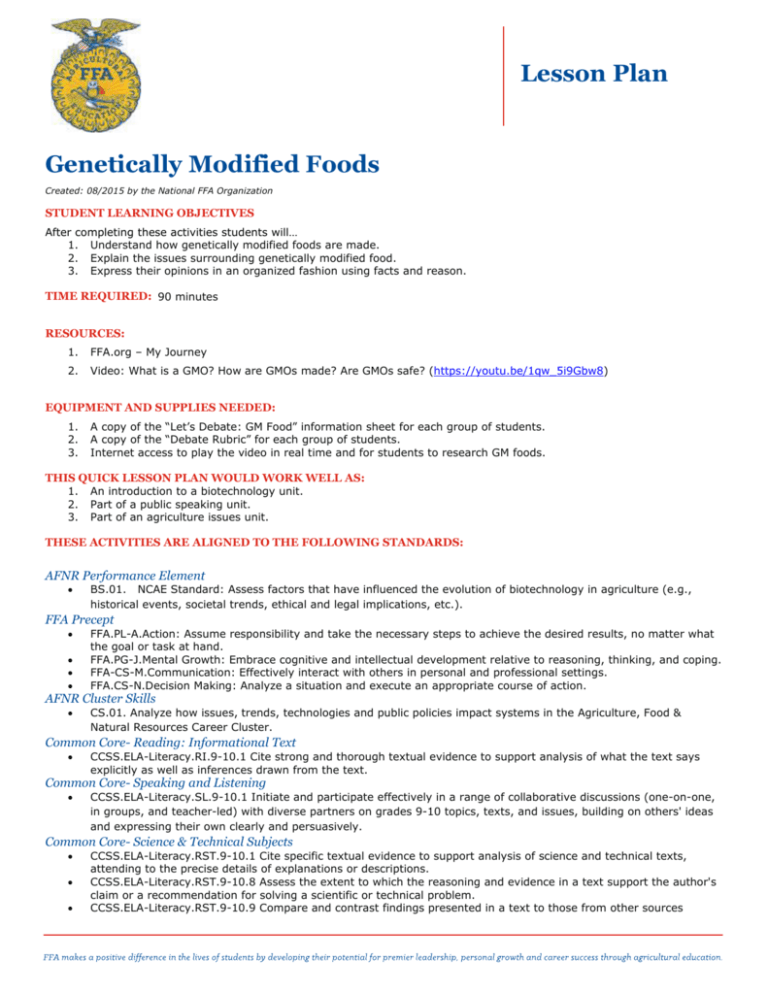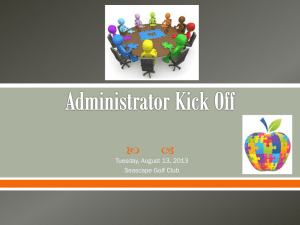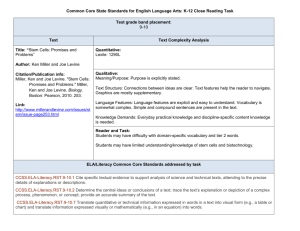GM Foods Lesson (Word 2007/docx)
advertisement

Lesson Plan Genetically Modified Foods Created: 08/2015 by the National FFA Organization STUDENT LEARNING OBJECTIVES After completing these activities students will… 1. Understand how genetically modified foods are made. 2. Explain the issues surrounding genetically modified food. 3. Express their opinions in an organized fashion using facts and reason. TIME REQUIRED: 90 minutes RESOURCES: 1. FFA.org – My Journey 2. Video: What is a GMO? How are GMOs made? Are GMOs safe? (https://youtu.be/1qw_5i9Gbw8) EQUIPMENT AND SUPPLIES NEEDED: 1. 2. 3. A copy of the “Let’s Debate: GM Food” information sheet for each group of students. A copy of the “Debate Rubric” for each group of students. Internet access to play the video in real time and for students to research GM foods. THIS QUICK LESSON PLAN WOULD WORK WELL AS: 1. 2. 3. An introduction to a biotechnology unit. Part of a public speaking unit. Part of an agriculture issues unit. THESE ACTIVITIES ARE ALIGNED TO THE FOLLOWING STANDARDS: AFNR Performance Element BS.01. NCAE Standard: Assess factors that have influenced the evolution of biotechnology in agriculture (e.g., historical events, societal trends, ethical and legal implications, etc.). FFA Precept FFA.PL-A.Action: Assume responsibility and take the necessary steps to achieve the desired results, no matter what the goal or task at hand. FFA.PG-J.Mental Growth: Embrace cognitive and intellectual development relative to reasoning, thinking, and coping. FFA-CS-M.Communication: Effectively interact with others in personal and professional settings. FFA.CS-N.Decision Making: Analyze a situation and execute an appropriate course of action. AFNR Cluster Skills CS.01. Analyze how issues, trends, technologies and public policies impact systems in the Agriculture, Food & Natural Resources Career Cluster. Common Core- Reading: Informational Text CCSS.ELA-Literacy.RI.9-10.1 Cite strong and thorough textual evidence to support analysis of what the text says explicitly as well as inferences drawn from the text. Common Core- Speaking and Listening CCSS.ELA-Literacy.SL.9-10.1 Initiate and participate effectively in a range of collaborative discussions (one-on-one, in groups, and teacher-led) with diverse partners on grades 9-10 topics, texts, and issues, building on others' ideas and expressing their own clearly and persuasively. Common Core- Science & Technical Subjects CCSS.ELA-Literacy.RST.9-10.1 Cite specific textual evidence to support analysis of science and technical texts, attending to the precise details of explanations or descriptions. CCSS.ELA-Literacy.RST.9-10.8 Assess the extent to which the reasoning and evidence in a text support the author's claim or a recommendation for solving a scientific or technical problem. CCSS.ELA-Literacy.RST.9-10.9 Compare and contrast findings presented in a text to those from other sources (including their own experiments), noting when the findings support or contradict previous explanations or accounts. Common Core- Literacy in Science & Technical Subjects: Writing CCSS.ELA-Literacy.WHST.9-10.1 Write arguments focused on discipline-specific content. CCSS.ELA-Literacy.WHST.9-10.4 Produce clear and coherent writing in which the development, organization, and style are appropriate to task, purpose, and audience. CCSS.ELA-Literacy.WHST.9-10.5 Develop and strengthen writing as needed by planning, revising, editing, rewriting, or trying a new approach, focusing on addressing what is most significant for a specific purpose and audience. CCSS.ELA-Literacy.WHST.9-10.6 Use technology, including the Internet, to produce, publish, and update individual or shared writing products, taking advantage of technology's capacity to link to other information and to display information flexibly and dynamically. CCSS.ELA-Literacy.WHST.9-10.8 Gather relevant information from multiple authoritative print and digital sources, using advanced searches effectively; assess the usefulness of each source in answering the research question; integrate information into the text selectively to maintain the flow of ideas, avoiding plagiarism and following a standard format for citation. CCSS.ELA-Literacy.WHST.9-10.9 Draw evidence from informational texts to support analysis, reflection, and research. Common Core- Math Practices CCSS.MP3: Construct viable arguments and critique the reasoning of others. CCSS.MP6: Attend to precision. AFNR Career Ready Practices CRP.02. Apply appropriate academic and technical skills. Career-ready individuals readily access and use the knowledge and skills acquired through experience and education to be more productive. CRP.04. Communicate clearly, effectively, and with reason. Career-ready individuals communicate thoughts, ideas and action plans with clarity, whether using written, verbal and/or visual methods. CRP.05. Consider the environmental, social and economic impact of decisions. Career-ready individuals understand the interrelated nature of their actions and regularly make decisions that positively impact and/or mitigate negative impact on other people, organizations and the environment. CRP.07. Employ valid and reliable research strategies. Career-ready individuals are discerning in accepting and using new information to make decisions, change practices or inform strategies. CRP.08. Utilize critical thinking to make sense of problems and persevere in solving them. Career-ready individuals readily recognize problems in the workplace, understand the nature of the problem, and devise effective plans to solve the problem. CRP.11 Use technology to enhance productivity. Career-ready individuals find and maximize the productive value of existing and new technology to accomplish workplace tasks and solve workplace problems." Partnership for 21st Century Skills Civic Literacy Communication Global Awareness Information Literacy Social and Cross-cultural Skills LESSON PLAN: 1. 2. 3. Interest Approach: Show the video “What is a GMO? How are GMOs made? Are GMOs safe?” This video is available on the September 2015 Explore page of My Journey. The direct url is https://youtu.be/1qw_5i9Gbw8. a. Allow students to react to the video. In a short discussion try to determine which students are pro-GMO, anti-GMO or have no opinion. Activity: Students will research and debate the topic of GM Foods. Divide the class into groups of four to five students. Make sure you have an even number of “For” and “Against” groups so that each debate only has two teams. a. Give each group a copy of the document “Let’s Debate: GM Foods.” This document explains the format of the debate and offers suggestions of websites to use for research. b. Suggestion: If a student has a really strong opinion on the topic have them debate the opposing view. This will be a challenge for them, but will also help them develop strong arguments. c. During the debate use the provided rubric to grade each group. You can also have the audience (students not currently debating) determine the winner of each debate. i. Tip: Share the rubric with students so they know how they will be evaluated. Follow-up: Have students share what they learned during their research that surprised them or that they did not already know. Also, have students share if their opinion on the topic changed due to the debates. Let’s Debate: GM Foods DIRECTIONS: Use the following information to research GM foods and plan your debate strategy. DEBATE FORMAT: 1. 2. 3. 4. 5. 6. Affirmative team opening statement (2 minutes) Opposing team opening statement (2 minutes) Affirmative team argument (5 minutes) Opposing team argument (5 minutes) Affirmative team rebuttal (1 minute) Opposing team rebuttal (1 minute) GM FOOD RESOURCES: These links are to sites and articles that cover both sides of the GM foods issue. 1. 2. 3. 4. http://biomed.brown.edu/arise/resources/docs/GM%20foods%20review.pdf http://learn.genetics.utah.edu/content/science/gmfoods/ https://gmoanswers.com/studies/top-10-long-term-gmo-health-studies http://www.responsibletechnology.org/posts/gmo-health-dangers/ Aligned to the following standards: BS.01; FFA.PL-A.; FFA.PG-J.; FFA.CS-M.; FFA.CS-N.; CS.01; CCSS.RI.9-10.1; CCSS.SL.9-10.1; CCSS.RST.9-10.1; CCSS.RST.9-10.8; CCSS.RST.9-10.9; CCSS.WHST.9-10.1; CCSS.WHST.9-10.4; CCSS.WHST.9-10.5; CCSS.WHST.9-10.6; CCSS.WHST.9-10.8; CCSS.WHST.9-10.9; CCSS.MP3; CCSS.MP6; CRP.02; CRP.04; CRP.05; CRP.07; CRP.08; CRP.11 Let’s Debate: GM Foods DIRECTIONS: Use the following information to research GM foods and plan your debate strategy. DEBATE FORMAT: 7. 8. 9. 10. 11. 12. Affirmative team opening statement (2 minutes) Opposing team opening statement (2 minutes) Affirmative team argument (5 minutes) Opposing team argument (5 minutes) Affirmative team rebuttal (1 minute) Opposing team rebuttal (1 minute) GM FOOD RESOURCES: These links are to sites and articles that cover both sides of the GM foods issue. 5. 6. 7. 8. http://biomed.brown.edu/arise/resources/docs/GM%20foods%20review.pdf http://learn.genetics.utah.edu/content/science/gmfoods/ https://gmoanswers.com/studies/top-10-long-term-gmo-health-studies http://www.responsibletechnology.org/posts/gmo-health-dangers/ Aligned to the following standards: BS.01; FFA.PL-A.; FFA.PG-J.; FFA.CS-M.; FFA.CS-N.; CS.01; CCSS.RI.9-10.1; CCSS.SL.9-10.1; CCSS.RST.9-10.1; CCSS.RST.9-10.8; CCSS.RST.9-10.9; CCSS.WHST.9-10.1; CCSS.WHST.9-10.4; CCSS.WHST.9-10.5; CCSS.WHST.9-10.6; CCSS.WHST.9-10.8; CCSS.WHST.9-10.9; CCSS.MP3; CCSS.MP6; CRP.02; CRP.04; CRP.05; CRP.07; CRP.08; CRP.11 Debate Rubric Criteria 5 points 4 points 3 points 2 points 1 point Respect for Other Team All statements, body language, and responses were respectful and used appropriate language Statements and responses were respectful and used appropriate language, but once or twice body language was not. Most statements and responses were respectful and used appropriate language, but there was one sarcastic remark. Statements, responses and/or body language were borderline appropriate. Some sarcastic remarks. Statements, responses and/or body language were consistently not respectful. Information All information presented in this debate was clear, accurate and thorough. Most information presented in this debate was clear, accurate and thorough. Most information presented in the debate was clear and accurate, but was not usually thorough. Some information was accurate, but there were some minor inaccuracies. Information had some major inaccuracies or was usually not clear. Rebuttal All counter-arguments were accurate, relevant and strong. Most counter-arguments were accurate, relevant, and strong. Some counter arguments were weak and irrelevant. Counter-arguments were not accurate and/or relevant. Use of Facts/Statistics Every major point was well supported with several relevant facts, statistics and/or examples. Every major point was adequately supported with relevant facts, statistics and/or examples. Some points were supported well, others were not. Most points were not supported. Organization All arguments were clearly tied to an idea (premise) and organized in a tight, logical fashion. Most arguments were clearly tied to an idea (premise) and organized in a tight, logical fashion. Most arguments were clearly tied to an idea (premise) but had limited organization. Only some arguments were tied to an idea (premise), and all arguments lacked organization. No arguments were tied to an idea (premise), and they exhibited no organization. Understanding of Topic The team clearly understood the topic in depth and presented their information forcefully and convincingly. The team clearly understood the topic in depth and presented their information with ease. The team seemed to understand the main points of the topic and presented those with ease. The team seemed to understand the main points of the topic, but didn’t present with ease. The team did not show an adequate understanding of the topic. Most counter-arguments were accurate and relevant, but several were weak. Every major point was supported with facts, statistics and/or examples, but the relevance of some was questionable. Total Points: Comments: Rubric Source: http://course1.winona.edu/shatfield/air/rubrics.htm Points








